Wow! That is a lot of seed for a 1/2 acre plot DR! Aside from the cereal grains (50# each per half acre is fine), I would not use that much clover and brassica seed on a full acre...of course I am drilling my seed - perhaps you are broadcasting?
Regarding timing, as others have mentioned, it all depends upon your latitude and the average first frost dates in your area. I am in Upper Michigan - Lat 46N - Zone 4b. With my average first frost date being in early to mid-September, I need to plant brassicas by early to mid-July in order to get a good 60 days growth on them. I now include a little clover in my brassica plantings but they don't really show up much until the following spring. I also broadcast some rye over the brassica plantings in mid-late August.
For establishing perennial clover plots I always start them in late August or September with a cover crop of cereal grains. Those clovers don't amount to much until the following spring either but the cereal grains provide a good nurse crop for the clovers and feed my deer during the fall and early spring. Once the rye or wheat (oats will winter kill here) gets taller than about 8-9 inches it won't be browsed much by deer but I am never in a hurry to terminate it as it doesn't hurt the clovers at all and I like a lot of thatch, whether that be for fawning cover, turkey bugging, a cover crop, a free crop of winter rye after mowing, or whatever. Thatch is your friend for soil health for sure.
I had not really thought much about decomposing rye using a lot of Nitrogen as it breaks don't but I suppose that is true. Nonetheless, I almost always have some legumes under the rye whether that is a nurse crop for clovers or a full cover crop so they are also producing N while the rye may be utilizing it. The terminated rye is also producing other nutrients like P and K into my soil as it decomposes so it is still a healthy nutrient cycling process IMO.
Like many of you, I used to mow my clovers a couple of times every year thinking the new growth would be preferred over taller clovers but I think that myth has been pretty much debunked by studies done by the University of Tennessee and others - so I don't mow clovers anymore. Here are some photos of clover use by our deer:
The strip on the right is just a strip of perennial clovers which I have around the outside edges of all of my food plots. The crop to the left is a brassica planting which I drilled on July 8th. This photo was taken one month later on August 5th. I included only 4# of clovers in with the brassicas seed (2# each of Med Red and Crimson per acre). You can't see any clovers here and they did not impact the growth of the brassicas at all.
View attachment 42164
The same plot on August 21 when I broadcasted cereal rye over top of the brassicas... I "spot" pails of rye seed around the plot to minimize my walking when I broadcast the seed.
View attachment 42165
The other end of the plot on the same date...
View attachment 42166
The same plot the following May 14th. All of the brassicas have been consumed by my deer and now the clovers and rye are coming up and still feeding my deer.
(On a side note - the dandelions and other broadleaf weeds that you see in the clover strip will be sprayed with a light dose of Gly in another week or so and will be gone for the rest of the year)
View attachment 42167
The other end of the plot on June 16th. The rye is way beyond being palatable to my deer but the clovers are doing well.
View attachment 42172
The other end of the plot on the same date. If you don't think the deer will browse clovers this tall...
View attachment 42174
think again!
View attachment 42175
There is no need to mow the clover or the rye IMO, until I am ready to plant the follow up crop.
I planted this small plot of perennial clovers the previous fall with a nurse crop of cereal rye. I had back surgery the following June and didn't get around to mowing the rye until August 5th. You would think that this much thatch would smother the new clovers...
View attachment 42176
Nope - by September 18th you wouldn't know there was any rye thatch there unless you looked under the clover....but it is there, preserving soil moisture, keeping weeds at bay and putting nutrients back into my soil as is slowly decomposes. Thatch is your friend.
View attachment 42177
BTW - Here is a photo of that same clover strip pictured above with the May dandelions. This is on June 18th - a month after spraying the clover strip with a light dose (3/4 Qt/Acre) of Gly. No dandelions, no grasses, no other broadleaf weeds - only clovers. One spraying per year in May is all it takes to maintain clovers perennially.
View attachment 42178


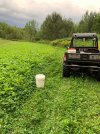

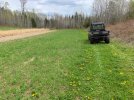
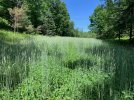
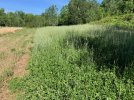
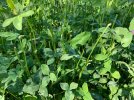

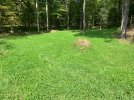
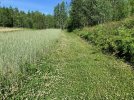
![IMG_6003[1].JPG IMG_6003[1].JPG](https://habitat-talk-data.xenforo.cloud/attachments/42/42275-61fc71fdd435f0938957f73d944898d0.jpg?hash=Yfxx_dQ18J)
![IMG_6006[1].JPG IMG_6006[1].JPG](https://habitat-talk-data.xenforo.cloud/attachments/42/42276-f41af3cd729eb138a66f36f342a9246d.jpg?hash=9BrzzXKesT)